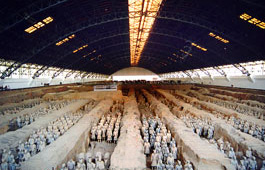| Legole.Com Discover china. Explore the beauty and wonder of the land, people, and culture of China. |
 |
|
|
 |
| |
| 221 BC - 206 BC |
 The king of the Qin state, Yinzheng, conquered the other six dukes through ten years of wars and brought an end to the riotous Warring States Period (476 BC - 221 BC) in 221 BC. He built up the Qin Dynasty - the first unified, multi-national, autocratic and power-centralized state in Chinese history - by making Xianyang, a city near Xian in the Shaanxi Province, his capital city. Although Qin is a short dynasty with a span of only fifteen years, it started off a 2,000-year-long imperial history in China and exerted a far-reaching influence on the subsequent dynasties. Except for frontiers in the west, southwest and northeast, Qin's territory has been kept fairly intact up to the present-day. To protect the northern frontier, the first Qin emperor ordered the construction of the Great Wall. He instituted centralism and a strict set of rules by which people lived in oppression. An army of peasants overthrew the harsh Qin regime just one year after the death of the Emperor Qin Shi Huang in 207 BC. The king of the Qin state, Yinzheng, conquered the other six dukes through ten years of wars and brought an end to the riotous Warring States Period (476 BC - 221 BC) in 221 BC. He built up the Qin Dynasty - the first unified, multi-national, autocratic and power-centralized state in Chinese history - by making Xianyang, a city near Xian in the Shaanxi Province, his capital city. Although Qin is a short dynasty with a span of only fifteen years, it started off a 2,000-year-long imperial history in China and exerted a far-reaching influence on the subsequent dynasties. Except for frontiers in the west, southwest and northeast, Qin's territory has been kept fairly intact up to the present-day. To protect the northern frontier, the first Qin emperor ordered the construction of the Great Wall. He instituted centralism and a strict set of rules by which people lived in oppression. An army of peasants overthrew the harsh Qin regime just one year after the death of the Emperor Qin Shi Huang in 207 BC.
Political History
The first Qin emperor lived from 259 BC to 210 BC. He was crowned at the age of 13 after his king father died. Since he was too young to administer his country, the real power was in the hand of the prime minister, Lu Buwei, who --allegedly--was the real father of the young emperor. Emperor Qin remained silent and continued to strengthen his own force. When the right occasion presented itself, he arrested the prime minister and sentenced him to death. Upon hearing the news, the prime minister did nothing but roar out in laughter, "Well done, well done, that is my boy."
The first Qin emperor seized the power at the age of 22 in 238 BC. Soon after, he launched a unification campaign from 230 BC to 221 BC. The emperor was a great politician. After unifying the country, he carried out a series of political reforms. He divided the country into 36 prefectures, which he again subdivided into more counties. All the regional governments were subordinate to the central government, which was ruled by the emperor himself. The first Qin emperor standardized the measurement of weight and length, written script, legal system and currency. He migrated thousands of people to southern border areas to pioneer the virgin land. Since the northern tribe the Xiongnu plundered the northern frontiers repeatedly, Emperor Qin appointed one of his excellent generals - Mengtian - to the northern areas. Mengtian beat back the Xiongnu tribe and supervised the construction of the Great Wall.
Despite all great jobs he did, Emperor Qin ruled as a ruthless tyrant. In order to standardize human thoughts, he burnt most of the books in the country to prevent freethinking. Furthermore, the emperor imposed heavy taxes and constrained thousands of people to work on the Great Wall. In the second year after his enthronement, he started the construction of his mausoleum, which took almost 700,000 conscripts over 30 years to complete. In order to continue his reign after his death, he also ordered the construction of the Terra-Cotta Army east of his mausoleum.
The tyranny of Emperor Qin Shi Huang and his successor resulted in wide opposition throughout the country. Peasant uprisings continually struck the regime of the Qin. Finally, in 207 BC, Xiangyu's army inflicted heavy losses on the Qin army; and in the following year, Liu Bang broke Xianyang, the capital of Qin, thus putting an end to the notorious Qin Dynasty.
Later, in pursuit of the domination of the country, a four-year war known as the Chu-Han War broke out between Xiangyu and Liu Bang. Finally, Liu Bang defeated Xiangyu in 202 BC and established the Han Dynasty (206 BC - 24 AD), after which he proclaimed himself the emperor of the Han.
|
|
|
 |
|
